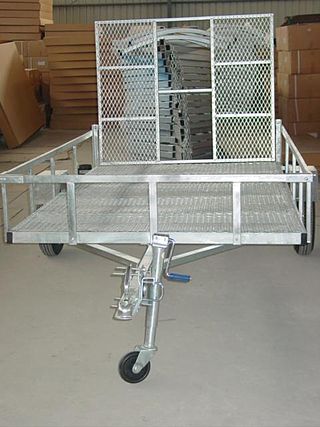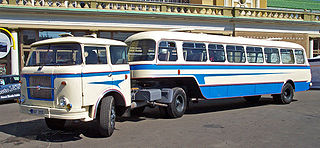
A bus is a motor vehicle that carries significantly more passengers than an average car or van, but fewer than the average rail transport. It is most commonly used in public transport, but is also in use for charter purposes, or through private ownership. Although the average bus carries between 30 and 100 passengers, some buses have a capacity of up to 300 passengers. The most common type is the single-deck rigid bus, with double-decker and articulated buses carrying larger loads, and midibuses and minibuses carrying smaller loads. Coaches are used for longer-distance services. Many types of buses, such as city transit buses and inter-city coaches, charge a fare. Other types, such as elementary or secondary school buses or shuttle buses within a post-secondary education campus, are free. In many jurisdictions, bus drivers require a special large vehicle licence above and beyond a regular driving license.

A semi-trailer truck is the combination of a tractor unit and one or more semi-trailers to carry freight. A semi-trailer attaches to the tractor with a type of hitch called a fifth wheel.

A road train, also known as a land train or long combination vehicle (LCV) is a semi-trailer used to move road freight more efficiently than single-trailer semi-trailers. It consists of one semi-trailer or more connected together with or without a prime-mover. It typically has to be at least three trailers and one prime-mover. Road trains are often used in areas where other forms of heavy transport are not feasible or practical.

A trailer is an unpowered vehicle towed by a powered vehicle. It is commonly used for the transport of goods and materials.There are two general categories of trailers: the full trailer and the semitrailer. A full trailer is a type of trailer whose entire weight is supported by its own wheels, with no weight transferred to the towing vehicle. In contrast, a semi-trailer is designed so that a portion of its weight is carried by its own wheels, while the remaining weight is borne by the towing vehicle.

An articulated bus, also referred to as a slinky bus, bendy bus, tandem bus, vestibule bus, stretch bus, or an accordion bus, is an articulated vehicle, typically a motor bus or trolleybus, used in public transportation. It is usually a single-decker, and comprises two or more rigid sections linked by a pivoting joint (articulation) enclosed by protective bellows inside and outside and a cover plate on the floor. This allows a longer legal length than rigid-bodied buses, and hence a higher passenger capacity (94–120), while still allowing the bus to maneuver adequately.

A dump truck, known also as a dumping truck, dump trailer, dumper trailer, dump lorry or dumper lorry or a dumper for short, is used for transporting materials for construction as well as coal. A typical dump truck is equipped with an open-box bed, which is hinged at the rear and equipped with hydraulic rams to lift the front, allowing the material in the bed to be deposited ("dumped") on the ground behind the truck at the site of delivery. In the UK, Australia, South Africa and India the term applies to off-road construction plants only and the road vehicle is known as a tip lorry, tipper lorry, tipper truck, tip truck, tip trailer or tipper trailer or simply a tipper.

A tractor unit, also known as a truck unit, lorry unit, power unit, prime mover, ten-wheeler, semi-tractor, semi-truck, semi-lorry, tractor cab, truck cab, lorry cab, big rig tractor, big rig truck or big rig lorry or simply a tractor, truck, lorry, semi, big rig or rig, is a characteristically heavy-duty towing engine that provides motive power for hauling a towed or trailered load. These fall into two categories: heavy- and medium-duty military and commercial rear-wheel-drive semi-tractors used for hauling semi-trailers, and very heavy-duty typically off-road-capable, often 6×6, military and commercial tractor units, including ballast tractors.

A semi-trailer is a trailer without a front axle. The combination of a semi-trailer and a tractor truck is called a semi-trailer truck.

A bi-articulated bus or double-articulated bus and sometimes train-bus, tram-bus, trackless tram or double bendy bus is a type of high-capacity articulated bus with an extra axle and a second articulation joint, as well as extended length. Bi-articulated buses tend to be employed in high-frequency core routes or bus rapid transit schemes rather than in conventional bus routes.

An articulated hauler, articulated dump truck (ADT), or sometimes a dump hauler, is a very large heavy-duty type of dump truck used to transport loads over rough terrain, and occasionally on public roads. The vehicle usually has all-wheel drive and consists of two basic units: the front section, generally called the tractor, and the rear section that contains the dump body, called the hauler or trailer section. Steering is made by pivoting the front in relation to the back by hydraulic rams. This way, all wheels follow the same path, making it an excellent off-road vehicle.

The Scania K series is a series of chassis in Scania's city bus and coach range with longitudinally, straight-up mounted engine at the rear, replacing the K- and L-type (L94) chassis of the 4 series. The K series was first presented on Busworld 2005 in Kortrijk, Belgium, and models were available from 2006.

The Scania 4-series low floor city bus and coach range was introduced by Scania in 1997 as a successor to the 3-series bus range.

A trailer bus is a trailer vehicle designed specifically for the transportation of passengers. Trailer buses typically comprise one of two forms:

Bus manufacturing, a sector of the automotive industry, manufactures buses and coaches.

A tank transporter is a combination of a heavy tractor unit or a ballast tractor and a mating full trailer, hydraulic modular trailer or semi-trailer, used for transporting tanks and other armoured fighting vehicles. Some also function as tank recovery vehicles, the tractors of which may be armoured for protection in combat conditions.

The Neoplan Skyliner is a double-deck multi-axle luxury touring coach built by German coach manufacturer Neoplan. It was introduced in 1967.

MAN Truck & Bus SE is a subsidiary of Traton, and one of the leading international providers of commercial vehicles. Headquartered in Munich, Germany, MAN Truck & Bus produces vans in the range from 3.0 to 5.5 t gvw, trucks in the range from 7.49 to 44 t gvw, heavy goods vehicles up to 250 t road train gvw, bus-chassis, coaches, interurban coaches, and city buses. MAN Truck & Bus also produces diesel and natural-gas engines. The MAN acronym originally stood for Maschinenfabrik Augsburg-Nürnberg AG, formerly MAN AG.

A rigid bus is a vehicle used in public transportation services with a single, rigid chassis. A bus of this type is to be contrasted with an articulated or bi-articulated bus, which will have two or more rigid sections linked by a pivoting joint, also with a trailer bus, which is formed out of a bus bodied semi-trailer pulled by a conventional tractor unit.

The Scania 3-series bus range was introduced by Scania in 1988 and was superseded by the 4-series bus range in 1999.

A bruck is a type of bus or coach built to combine goods and passenger transport where it is most profitable or most convenient compared to separate vehicles. The word bruck was used in North America. In Australia they were known as passenger-freighters. In Europe they are known as Kombinationsbus (German), seka-auto (Finnish), kombibuss (Norwegian) and godsbuss (Swedish), with even the nickname skvader. They have for practical reasons mostly been built on front- or mid-engined chassis. In North America and Australia this type of bus was introduced in the late 1940s as a replacement for unprofitable railway lines, while in Europe they have been around since the first buses.

























